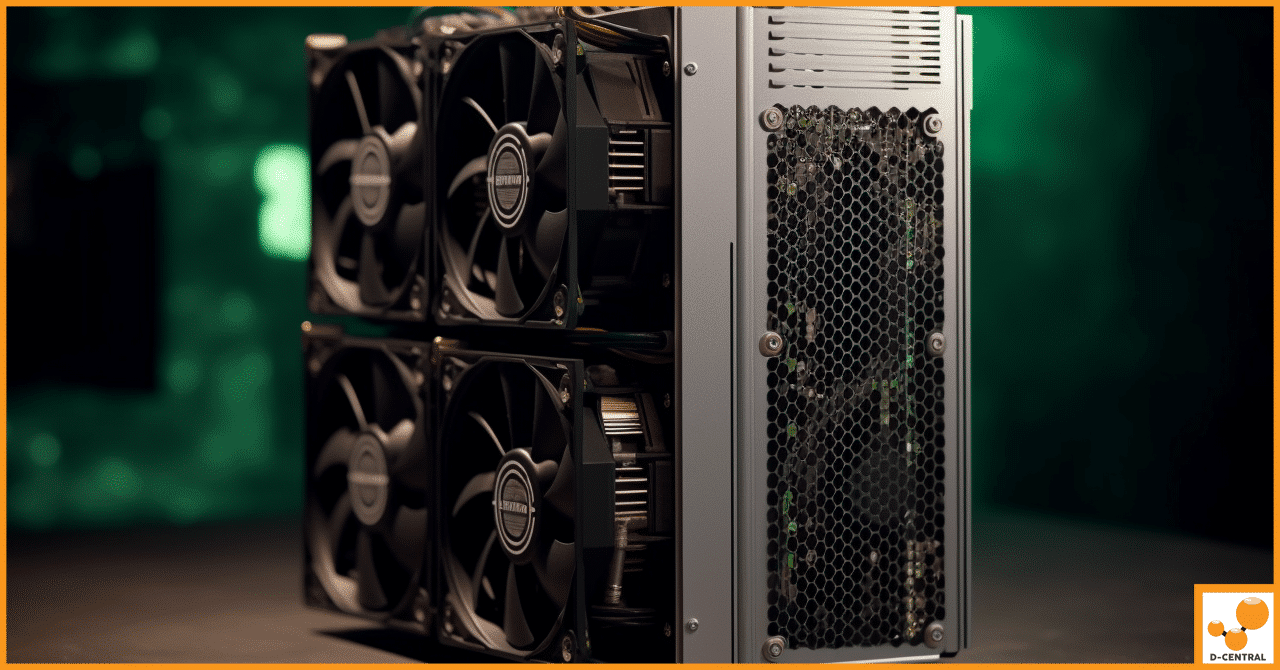
Demystifying Bitcoin’s Security Model: A Comprehensive Guide
In the ever-evolving landscape of cryptocurrencies, Bitcoin stands as a pioneering force that has revolutionized the way we perceive and
4479 Desserte Nord Autoroute 440, Laval, QC H7P 6E2

In the dynamic world of cryptocurrency, Bitcoin mining stands as a cornerstone activity, underpinning the decentralized ethos of digital currency. At the heart of this process are Application-Specific Integrated Circuit (ASIC) miners, specialized hardware engineered to solve complex mathematical puzzles that validate transactions and secure the Bitcoin network. These powerful machines are the workhorses of the mining world, offering unparalleled efficiency and processing power compared to their predecessors, such as CPUs and GPUs.
However, the relentless pursuit of Bitcoin rewards does not come without its challenges. ASIC miners, for all their prowess, are subject to wear and tear, reduced efficiency, and eventual obsolescence as newer, more powerful models enter the market. This is where the concept of miner refurbishment gains its significance. Refurbishing ASIC miners—revitalizing old machines through repair, component replacement, and optimization—has emerged as a vital practice for miners looking to sustain their operations economically and environmentally.
The relevance of miner refurbishment in the crypto mining industry is growing for several reasons. Economically, it offers a cost-effective alternative to the constant cycle of purchasing new equipment, allowing miners to maximize their investments in hardware. Environmentally, it contributes to sustainability by extending the life of miners and reducing electronic waste. Furthermore, in a market where the efficiency of mining equipment can significantly impact profitability, refurbishment ensures that miners maintain competitive edge without the need for constant capital outlay on new hardware.
As the crypto landscape continues to evolve, the practice of refurbishing ASIC miners is becoming an indispensable strategy for those committed to the long-term viability of their mining endeavors. It represents a convergence of economic savvy, environmental responsibility, and technological adeptness, marking a mature approach to the challenges and opportunities of Bitcoin mining.
The relentless quest for Bitcoin and other cryptocurrencies has necessitated the evolution of mining technology, with ASIC (Application-Specific Integrated Circuit) miners at the forefront of this revolution. These devices are tailor-made to mine cryptocurrencies with unmatched efficiency, but their constant operation under intense conditions can lead to wear and the eventual need for refurbishment.
ASIC miners are the gold standard in cryptocurrency mining hardware, designed specifically to perform the hashing functions required to secure a blockchain. Unlike their predecessors—CPUs, GPUs, and FPGAs—ASIC miners are not general-purpose devices; they are built to execute one particular task: mining a specific cryptocurrency, most notably Bitcoin, with unparalleled efficiency and speed.
This specialization allows ASIC miners to offer significant advantages in terms of hash rate and energy consumption, directly impacting the profitability of mining operations. The introduction of ASIC miners marked a pivotal moment in cryptocurrency mining, shifting it from a hobbyist activity to a professional and industrial-scale operation. However, the very efficiency that makes ASICs valuable also subjects them to intense wear and tear, underscoring the importance of timely refurbishment.
Recognizing when an ASIC miner needs refurbishment is crucial for maintaining optimal mining operations. Several signs indicate the need for attention:
Timely refurbishment in response to these signs can not only extend the life of ASIC miners but also ensure they continue to operate at peak efficiency, safeguarding the profitability of mining operations. Ignoring these signs can lead to more significant failures, resulting in costly downtime or the need for complete replacement.
The refurbishment of ASIC miners presents a compelling proposition for the cryptocurrency mining community. Beyond extending the operational life of mining hardware, refurbishment offers significant benefits in terms of cost efficiency, environmental sustainability, and performance improvements. These advantages make refurbishment an attractive option for miners aiming to optimize their operations.
One of the most immediate benefits of refurbishing ASIC miners is the substantial cost savings it offers compared to purchasing new equipment. As the cryptocurrency mining landscape becomes increasingly competitive, the ability to maintain a cost-effective operation is paramount. Refurbishment can reduce operational costs in several ways:
The environmental benefits of refurbishing ASIC miners are increasingly recognized within the cryptocurrency community. As concerns over the ecological footprint of mining grow, refurbishment offers a way to mitigate some of these impacts:
Refurbishment is not merely about returning miners to their original state; it also offers opportunities for performance enhancements. These improvements can lead to increased mining efficiency and profitability:
In summary, the refurbishment of ASIC miners offers a multifaceted approach to maintaining and enhancing cryptocurrency mining operations. By embracing refurbishment, miners can achieve cost savings, contribute to environmental sustainability, and enjoy performance improvements, ensuring their operations remain competitive and profitable in the long term.
Refurbishing ASIC miners is a meticulous process that involves several critical steps to ensure that the equipment is restored to its optimal performance. This process not only extends the life of the miners but also enhances their efficiency and reliability. Understanding the refurbishment process can help miners make informed decisions about maintaining their hardware.
The first step in the refurbishment process is a comprehensive diagnosis and assessment of the ASIC miner’s condition. This stage is crucial for identifying the issues affecting the miner’s performance and determining the extent of refurbishment needed. The diagnosis and assessment process typically involves:
Based on the findings from these steps, a refurbishment plan is developed, outlining the necessary repairs, replacements, and upgrades to restore the miner’s performance.
Once the diagnosis is complete, the repair and replacement phase begins. This phase is the heart of the refurbishment process, where identified issues are addressed to bring the miner back to optimal condition. Key aspects of this phase include:
The final step in the refurbishment process is rigorous testing and quality assurance. This phase ensures that the refurbished miner meets specific performance standards before it is returned to operation. Key testing and quality assurance activities include:
Through diagnosis and assessment, repair and replacement, and rigorous testing and quality assurance, the refurbishment process breathes new life into ASIC miners, ensuring they continue to contribute effectively to cryptocurrency mining operations.
Selecting a reputable refurbishment service is crucial for ensuring that your ASIC miners are restored to their optimal condition and can continue to operate efficiently. The right service provider can make a significant difference in the longevity and performance of your mining hardware. Here are key considerations to help you choose the best refurbishment service for your needs.
The expertise and certifications of a refurbishment service are fundamental indicators of its ability to deliver high-quality repairs and upgrades. When evaluating potential service providers, consider the following criteria:
The warranty and support offered by a refurbishment service are critical components of the value they provide. These elements offer peace of mind and assurance of the quality of the refurbishment work.
Choosing the right refurbishment service involves careful consideration of the provider’s certifications, expertise, warranty offerings, and support structure. By selecting a service that meets these criteria, you can ensure that your ASIC miners are refurbished to the highest standards, enhancing their performance and extending their operational life.
The decision between undertaking the refurbishment of ASIC miners as a DIY project or opting for professional services is pivotal. Each route offers distinct advantages and challenges. Understanding when to consider DIY refurbishment and the benefits of professional services can help miners make informed decisions that align with their capabilities, resources, and goals.
A DIY approach to refurbishing ASIC miners may be appealing for several reasons, including cost savings and the hands-on experience it offers. However, it’s essential to recognize when this approach is feasible. Here are some guidelines to help determine if DIY refurbishment is the right choice:
While the DIY approach has its merits, professional refurbishment services offer several advantages that can outweigh the benefits of a DIY project, especially for miners who lack the time, tools, or technical expertise. Here are the key benefits of opting for professional services:
In summary, while DIY refurbishment can be a rewarding project for those with the necessary skills and resources, professional refurbishment services offer distinct advantages in terms of expertise, efficiency, and reliability. These benefits make professional services an attractive option for miners seeking to maximize the performance and longevity of their ASIC miners.
Maintaining the operational efficiency and prolonging the lifespan of ASIC miners are crucial for maximizing the profitability of cryptocurrency mining operations. Through regular maintenance and timely upgrades, miners can ensure their hardware remains competitive and efficient in the ever-evolving mining landscape.
Preventative maintenance is key to extending the life of ASIC miners. By adhering to a routine maintenance schedule, miners can prevent many common issues that lead to hardware failure. Here are essential maintenance tips:
Beyond regular maintenance, monitoring performance and knowing when to upgrade are vital for keeping ASIC miners competitive.
By implementing regular maintenance routines, closely monitoring performance, and considering timely upgrades, miners can significantly extend the life and enhance the efficiency of their ASIC miners. These practices not only contribute to the sustainability of mining operations but also ensure that miners remain competitive in the fast-paced world of cryptocurrency mining.
The journey through the intricacies of ASIC miner refurbishment underscores the pivotal role that maintenance, repair, and strategic upgrades play in the lifecycle of cryptocurrency mining hardware. From understanding the critical signs that signal the need for refurbishment to navigating the choice between DIY efforts and professional services, it’s clear that the path to sustaining mining operations is multifaceted.
We’ve explored the substantial benefits that refurbishment offers, not just in terms of cost efficiency and performance improvements but also in contributing to environmental sustainability by reducing electronic waste. The detailed walkthrough of the refurbishment process, from diagnosis and assessment through to repair, replacement, and rigorous testing, highlights the meticulous care required to breathe new life into ASIC miners.
Moreover, the discussion on regular maintenance tips and the importance of monitoring and timely upgrades provides a blueprint for miners to not only extend the life of their equipment but also to ensure its continued competitiveness in the dynamic landscape of cryptocurrency mining.
Refurbishment emerges not just as a technical necessity but as a strategic investment in the longevity and efficiency of mining operations. It’s a testament to the resilience and adaptability required in the fast-paced world of cryptocurrency mining, where efficiency and sustainability are paramount.
We encourage miners to view refurbishment as a cost-effective and environmentally friendly strategy for maximizing the return on their hardware investments. Whether opting for a DIY approach or seeking the expertise of professional refurbishment services, the goal remains the same: to ensure that mining hardware continues to operate at its peak, contributing to the security and vitality of the blockchain networks it supports.
For those looking to delve deeper into the possibilities of ASIC miner refurbishment or seeking guidance on the best practices for maintenance and upgrades, exploring reputable refurbishment services or consulting with experts can provide valuable insights and support. By embracing the principles of regular maintenance, performance monitoring, and timely refurbishment, miners can secure the future of their operations, ensuring that they remain at the forefront of cryptocurrency mining innovation and sustainability.
What is an ASIC miner?
An Application-Specific Integrated Circuit (ASIC) miner is a specialized hardware designed to mine cryptocurrency efficiently by solving complex mathematical puzzles essential for validating transactions and securing the network. They are optimized for cryptocurrency mining and offer superior efficiency and processing power.
Why is refurbishment of ASIC miners necessary?
Refurbishment is vital for sustaining mining operations economically and environmentally. It offers a cost-effective alternative to purchasing new equipment, extends the life of miners, reduces electronic waste, and ensures miners maintain a competitive edge by staying efficient and productive.
What are the signs that an ASIC miner needs refurbishment?
Signs include decreased hash rate, increased power consumption, overheating, frequent crashes or errors, visible physical damage, and loud or unusual noises. Recognizing these signs is crucial for maintaining optimal mining operations.
What are the benefits of refurbishing ASIC miners?
Refurbishing ASIC miners brings benefits such as cost efficiency by extending hardware lifespan and reducing capital expenditure, environmental sustainability by lessening electronic waste and improving energy efficiency, and performance improvements through hardware optimization and reliability enhancements.
What does the refurbishment process involve?
The process involves diagnosis and assessment to identify issues, repair and replacement of faulty components, and testing and quality assurance to ensure refurbished miners meet performance standards. The goal is to restore or enhance the miner’s efficiency and reliability.
How does one choose the right refurbishment service?
Choosing the right service involves considering aspects like certifications and expertise, the warranty and support offered, the provider’s reputation in the mining community, and the availability of quality spare parts. A reputable service can significantly impact the longevity and performance of refurbished ASIC miners.
What are the differences between DIY and professional refurbishment?
DIY refurbishment might appeal due to potential cost savings and hands-on control if you have the necessary technical expertise, tools, and risk tolerance. Professional services offer advantages such as expert knowledge, advanced diagnostic tools, warranty and ongoing support, and efficient risk mitigation.
How can one extend the life of their ASIC miner?
Extending the life of ASIC miners involves regular maintenance, monitoring performance, and considering timely upgrades. Key maintenance practices include keeping the miner clean, ensuring adequate ventilation, and updating firmware. Performance monitoring and upgrades are vital for maintaining competitive efficiency.
DISCLAIMER: D-Central Technologies and its associated content, including this blog, do not serve as financial advisors or official investment advisors. The insights and opinions shared here or by any guests featured in our content are provided purely for informational and educational purposes. Such communications should not be interpreted as financial, investment, legal, tax, or any form of specific advice. We are committed to advancing the knowledge and understanding of Bitcoin and its potential impact on society. However, we urge our community to proceed with caution and informed judgment in all related endeavors.
Related Posts

In the ever-evolving landscape of cryptocurrencies, Bitcoin stands as a pioneering force that has revolutionized the way we perceive and

The world of Bitcoin mining has undergone significant transformations since the inception of this pioneering cryptocurrency. Central to these changes

If you are familiar with the cryptocurrency mining industry, chances are you’ve heard about the Antminer S9. As one of